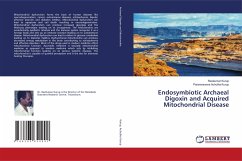Endogenous digoxin has been related to the pathogenesis of Schizophrenia, malignancy, metabolic syndrome X, autoimmune disease and neuronal degeneration. The possibility of endogenous digoxin synthesis by actinide based primitive organism like archaea with a mevalonate pathway and cholesterol catabolism was considered. An actinide dependent shadow biosphere of archaea and viroids in the above mentioned disease states is described. Metal actinides in beach sands have been postulated to play a role in abiogenesis. A hypothesis of cholesterol as the primal prebiotic molecule synthesised on actinide surfaces with all other biomolecules arising from it and a self replicating cholesterol lipid organism as the initial life form is presented. The archaea exists as an endosymbiont in the human cell and can be considered as a cellular organelle. The endosymbiotic archaeal digoxin is concerned with cell regulation as well as neuro-immuno-endocrine-genetic-metabolic regulation. It can be considered as the premier molecule of life and key to human biology.








